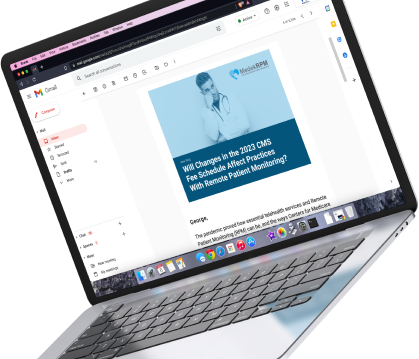
Remote patient monitoring (RPM), also known as remote physiologic monitoring, is an excellent healthcare option for patients with numerous chronic conditions, including asthma. RPM can be particularly advantageous when caring for older adults with this condition.
As the US population continues to age, research has revealed that asthma morbidity and mortality rates are highest among those older than 65 years. This may be because it has been found that adult asthma, although relatively common, is underdiagnosed. In fact, some investigators have proposed the term “geriatric asthma,” to better reflect the many different clinical features of the condition (versus childhood asthma).1,2
Responding to Needs of Older Adults with Asthma
The potential benefits of remote patient monitoring for older adults with asthma are reflected in the decision of The Centers for Medicare and Medicaid Service (CMS) to significantly expand reimbursement by designating the following CMS Codes:
- 99453
- 99454
- 99457
- 99458
The above codes cover the broad continuum of patient care, including initial set-up and patient education, data collection, and follow-up monitoring.
ADDITIONAL RESOURCE: Details on Medicare CMS Codes and reimbursement figures.
Addressing the Unique Challenges of the 65-Plus Population
There are several factors that can complicate effective asthma diagnosis and treatment in the older population. For instance, signs and symptoms of asthma can be similar to Chronic Obstructive Pulmonary Disease (COPD) or other diagnoses common among the elderly. As we all know, the older a patient gets, the longer their list of medical conditions.3 Challenges are compounded by productivity requirements that limit the ability of physicians to really engage with patients. The unfortunate result is increased difficulty in providing high-quality, patient-centered care.
This is why remote patient monitoring serves as a valuable assessment and treatment strategy that certainly doesn’t replace, but complements the expertise of the physicians, nurses, and other providers. RPM offers several definitive benefits to asthma care:
- Knowledge of RPM measures in real-time, between office visits.
- The ability to analyze trends in patient status.
- Providers can make medical recommendations based on multiple data points, not just a single visit.
- Minimizing the need for patients and their families to struggle with transportation issues.
- Enhanced ability for the provider to establish more effective patient self-management and education.
- The ability to reach patients in rural areas and still apply for reimbursement.
*With Medek RPM technologies, data is collected as often as daily. All patient information is sent securely through a HIPAA-compliant database. Medek practice staff also provide clinical reviews of patient data for providers.
COVID-19
The intense challenges of the COVID-19 pandemic certainly underscored the value of remote patient monitoring. Not only were patients who had COVID prevented from seeing their doctors and nurses, but patients who didn’t have the virus were afraid to leave their homes. Although RPM had been around long before the pandemic, obtaining basic measures such as glucose levels, pulse oximetry, blood pressure, and weight was suddenly a huge challenge.
Doctors treating patients with difficult-to-control asthma realized the immediate necessity to do a “strong pivot” and learn how to treat patients using remote patient monitoring.4 Indeed, it was an inflection point for the broader uptake of this technology and has changed the way patient care is being delivered and received.
Governmental Support for Remote Patient Monitoring
The Department of Health and Human Services (HHS) emphasizes the value of RPM for multiple chronic diseases, including asthma. They advise providers to talk to their patients about RPM because of the following advantages:
- Better contact with providers for patients living in rural areas.
- Shorter hospital stays – because patients can be discharged sooner with RPM devices.
- Reduced risk of exposure to COVID-19 and other contagious illnesses.
HHS also points out that RPM aids in protecting healthcare workers from contagious illnesses.5
In Summary
As we have learned, adult asthma is frequently underdiagnosed, and therefore undertreated. Remote patient monitoring may provide additional insight regarding specific differential diagnoses. It complements the expertise of healthcare providers by ensuring real-time data between office visits. Ultimately, it expands the reach of physicians’ practices into rural areas as well as to patients who have difficulty getting to a physical clinic.
CMS has developed reimbursement policies for remote patient monitoring that continue, even as the US has lifted COVID-19 restrictions. Furthermore, HHS encourages providers to explore with their patients the possibility of incorporating RPM into their daily health regimen.6
Learn More About Medek Remote Patient Monitoring Technologies
Medek employs a dedicated RPM Patient Care Team, which is a well-trained group of nurse practitioners, physician assistants, and registered nurses that monitor your patients’ readings. All data is clearly documented in patient records, with out-of-bounds readings initiating timely communication protocols.
Our billing team ensures compliance with insurance reimbursement requirements. This allows your medical care team to do what they do best: high-quality patient-centered care.
Sources
- Baptist, A. P., & Busse, P. J. (2018). Asthma Over the Age of 65: All’s Well That Ends Well. The journal of allergy and clinical immunology. In practice, 6(3), 764–773. https://doi.org/10.1016/j.jaip.2018.02.007
- Battaglia, S., Benfante, A., Spatafora, M., & Scichilone, N. (2016). Asthma in the elderly: a different disease?. Breathe (Sheffield, England), 12(1), 18–28. https://doi.org/10.1183/20734735.002816.
- Ibid.
- Todak, A. (2022, February 25). Speaker: ‘Potential is high’ for remote patient monitoring in difficult-to-control asthma. https://www.healio.com/news/allergy-asthma/20220226/speaker-potential-is-high-for-remote-patient-monitoring-in-difficulttotreat-asthma.
- Telehealth.HHS (2022, August 26). Telehealth and remote patient monitoring. Telehealth HHS. https://telehealth.hhs.gov/providers/preparing-patients-for-telehealth/telehealth-and-remote-patient-monitoring/
- Ibid.





